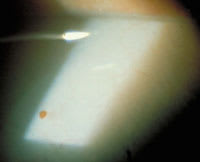contact
lens care
Soft
Contact Lens Deposition — Part 2
BY
SUSAN J. GROMACKI, OD, MS, FAAO
Discomfort is a well-documented reason for contact lens discontinuation. Contact lens deposition is a primary etiology for this discomfort. We must learn to recognize the different types of contact lens deposits and how to manage them if we want to maximize comfort — and as a result, contact lens success — for our patients. In Part 1 of this ser- ies, I discussed protein, lipid and microorganism deposition. Following are three more types of deposits that can affect comfortable contact lens wear.
|
|
|
Figure 1. Lens calculi (jelly bumps). |
Lens Calculi
Also known as jelly bumps or mulberry spots, these raised circular bumps penetrate the front surface of the contact lens (Figure 1). Composed of lipid, protein and calcium, they result from improper lens handling and care. They're more common with high-water-content or extended wear lenses and in patients who have high fat, protein and alcohol intake; low tear potassium; dry eye; or incomplete blinking. The upper eyelid may be irritated by the deposit or grab onto it, causing the lens to decenter. Because removal would result in pits in the front lens surface, the contact lenses need to be replaced.
Also,
it's important to re-educate the patient on proper contact lens care. It can be
valuable to demonstrate to the patient — using a biomicroscope under high magnification
and illumination — the appearance of his deposited lenses. You may also consider
refitting at-risk patients into lower-
water-content or GP lenses.
Because I primarily prescribe soft contact lenses in a disposable modality, the incidence of these deposits in my practice is much less than it used to be. I still keep a special watch, however, for jelly bumps in the conventional lenses that I do fit, such as prosthetic opaque contact lenses.
Rust Spots
|
|
|
Figure 2. Rust spot. (Courtesy of Dr. Ron Watanabe) |
Appearing as small orange or red circular spots (Figure 2), you can find these on new lenses. They are, however, highly associated with tap water use. As a result, it's important to provide documentation and thorough patient education.
Another etiology can be a metallic particle from the environment. In this case, perform a thorough slit lamp examination to rule out the presence of a metallic foreign body in the eye. Most often, the rust spot itself causes no discomfort to the patient and lens replacement isn't necessary.
Cosmetics
Cosmetics include makeup, mascara, after-shave lotion, soap or suntan lotion. They adhere readily to soft contact lenses, appearing iridescent, filmy or greasy. Over time, their accumulation can cause discomfort and decrease visual acuity. To avoid contamination, instruct patients to apply their lenses prior to applying cosmetics. In addition, advise patients to take out their contact lenses before removing their makeup.
Dr. Gromacki has served as a faculty member at the University of Michigan Department of Ophthalmology and Visual Sciences.





